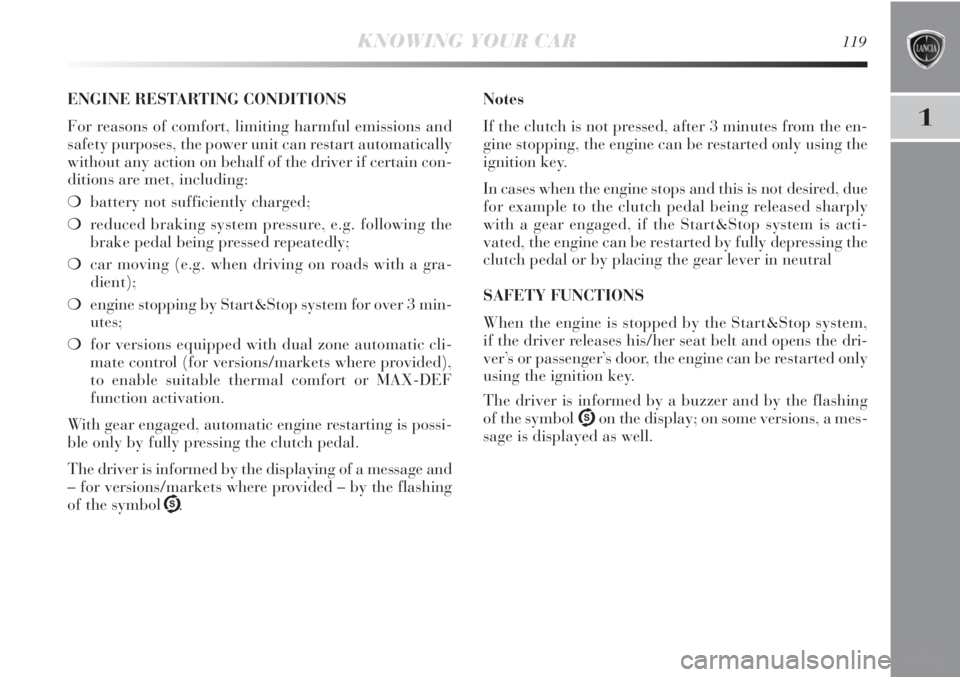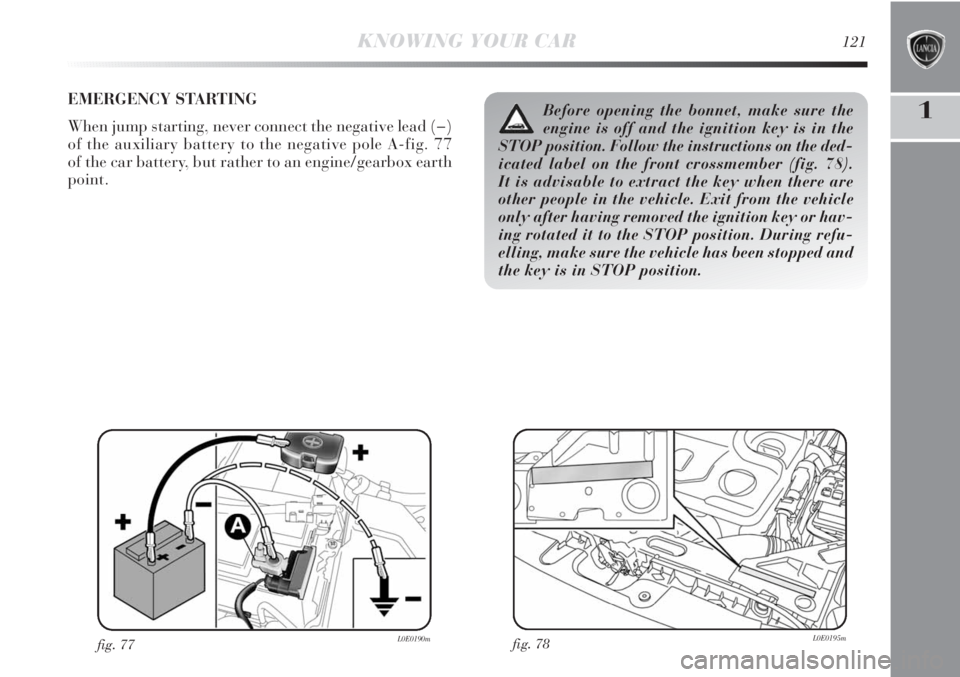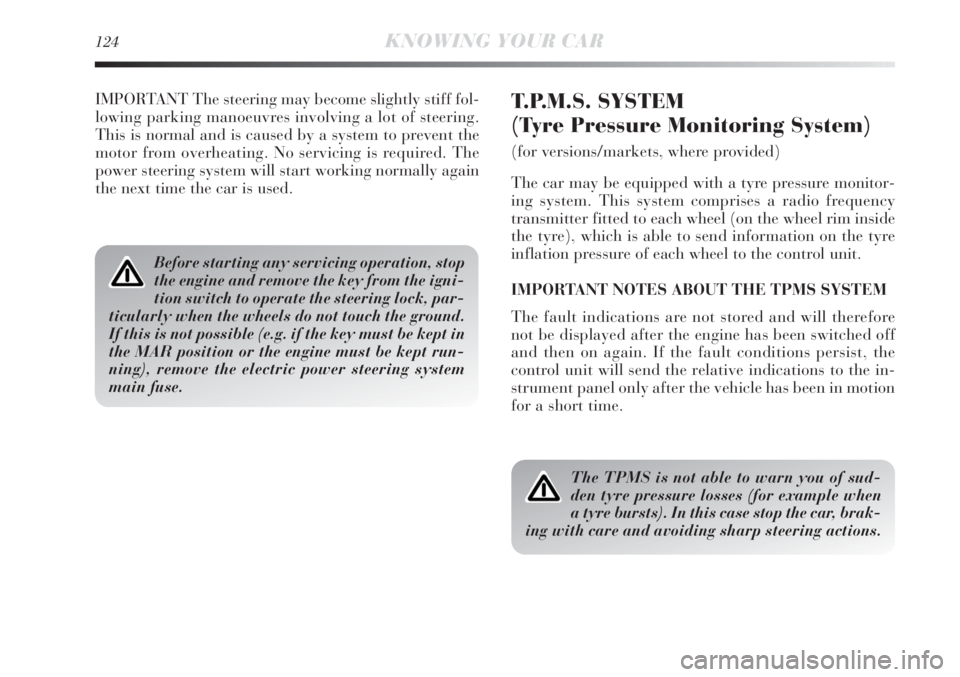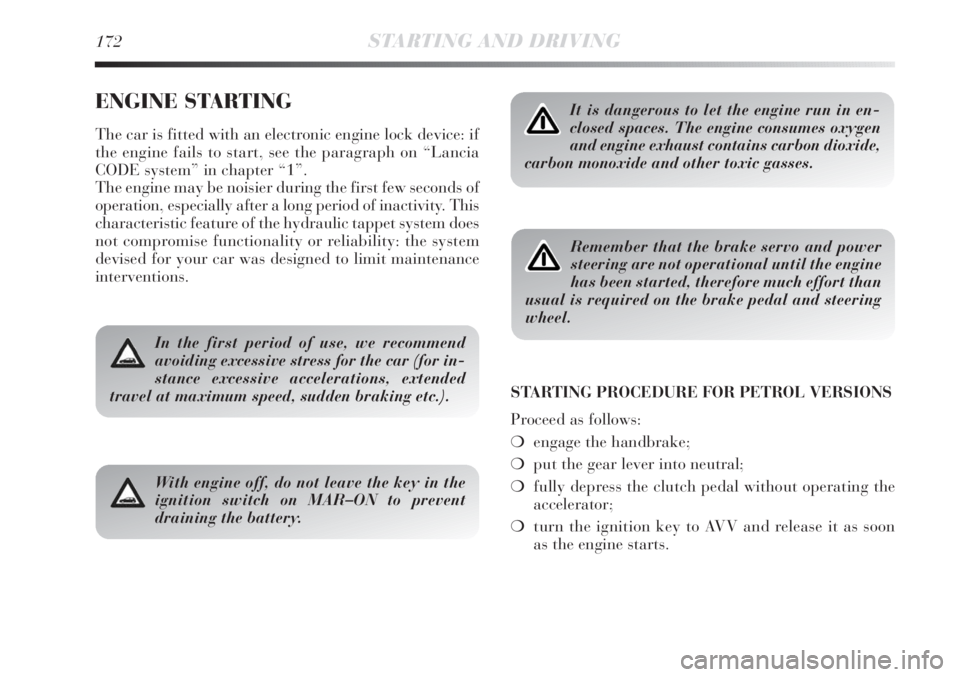key Lancia Delta 2011 Owner handbook (in English)
[x] Cancel search | Manufacturer: LANCIA, Model Year: 2011, Model line: Delta, Model: Lancia Delta 2011Pages: 290, PDF Size: 8.36 MB
Page 120 of 290

1
KNOWING YOUR CAR119
ENGINE RESTARTING CONDITIONS
For reasons of comfort, limiting harmful emissions and
safety purposes, the power unit can restart automatically
without any action on behalf of the driver if certain con-
ditions are met, including:
❍battery not sufficiently charged;
❍reduced braking system pressure, e.g. following the
brake pedal being pressed repeatedly;
❍car moving (e.g. when driving on roads with a gra-
dient);
❍engine stopping by Start&Stop system for over 3 min-
utes;
❍for versions equipped with dual zone automatic cli-
mate control (for versions/markets where provided),
to enable suitable thermal comfort or MAX-DEF
function activation.
With gear engaged, automatic engine restarting is possi-
ble only by fully pressing the clutch pedal.
The driver is informed by the displaying of a message and
– for versions/markets where provided – by the flashing
of the symbol U.Notes
If the clutch is not pressed, after 3 minutes from the en-
gine stopping, the engine can be restarted only using the
ignition key.
In cases when the engine stops and this is not desired, due
for example to the clutch pedal being released sharply
with a gear engaged, if the Start&Stop system is acti-
vated, the engine can be restarted by fully depressing the
clutch pedal or by placing the gear lever in neutral
SAFETY FUNCTIONS
When the engine is stopped by the Start&Stop system,
if the driver releases his/her seat belt and opens the dri-
ver’s or passenger’s door, the engine can be restarted only
using the ignition key.
The driver is informed by a buzzer and by the flashing
of the symbol Uon the display; on some versions, a mes-
sage is displayed as well.
Page 121 of 290

120KNOWING YOUR CAR
ENERGY SAVING FUNCTION
(for versions/markets where provided)
If, as a result of the automatic engine restarting, the dri-
ver does not carry out any action on the vehicle for over
3 minutes, the Start&Stop system stops the engine once
and for all, to prevent fuel consumption. In these cases,
the engine can be restarted only by using the ignition key.
NOTE In any case, it is possible to keep the engine run-
ning by deactivating the Start&Stop system.
OPERATING IRREGULARITIES
In the event of malfunction, the Start&Stop system is de-
activated. The driver is informed about the failure
through the switching-on of the symbol Uon the in-
strument panel and – for some versions – through the
displaying of a message. In this case, go to a Lancia
Dealership.CAR INACTIVITY
In cases of car inactivity, special attention must be paid
due to the disconnection of the battery power supply.
Proceed as follows: detach the connector A-fig. 76 (by
pressing button B) from sensor C for monitoring the sta-
tus of the battery installed on the negative battery pole
D. This sensor should never be disconnected from the
pole except if the battery is replaced.
fig. 76L0E0191m
When replacing the battery, always contact
a Lancia Dealership. Replace the battery
using a new one of the same type (HEAVY
DUTY) and with the same specifications.
Page 122 of 290

1
KNOWING YOUR CAR121
EMERGENCY STARTING
When jump starting, never connect the negative lead (−)
of the auxiliary battery to the negative pole A-fig. 77
of the car battery, but rather to an engine/gearbox earth
point.
fig. 77L0E0190mfig. 78L0E0195m
Before opening the bonnet, make sure the
engine is off and the ignition key is in the
STOP position. Follow the instructions on the ded-
icated label on the front crossmember (fig. 78).
It is advisable to extract the key when there are
other people in the vehicle. Exit from the vehicle
only after having removed the ignition key or hav-
ing rotated it to the STOP position. During refu-
elling, make sure the vehicle has been stopped and
the key is in STOP position.
Page 123 of 290

122KNOWING YOUR CAR
EOBD SYSTEM
The EOBD system (European On Board Diagnosis) car-
ries out a continuous diagnosis of the components of the
car related to emissions. It also alerts the driver, by turn-
ing on the
Uwarning light in the instrument panel to-
gether with a message in the reconfigurable multifunc-
tion display, when these components are no longer in
peak condition (see “Instrument panel warning lights”
chapter).
The goal of the system is to:
❍to keep system efficiency under control;
❍to signal a fault which causes emission levels to in-
crease;
❍to signal the need to replace deteriorated components.
The system also has a diagnosis connector that can be in-
terfaced to suitable instruments, to read the error codes
stored in the control unit together with a series of specific
parameters for engine operation and diagnosis.
This check can also be carried out by traffic control au-
thorities.
IMPORTANT After eliminating the problem, to check the
system completely, Lancia Dealerships run a bench test
and, if necessary, road tests which may also call for a long
journey.
Go to a Lancia Dealership as soon as pos-
sible if warning light
Ueither does not light
up when the key is turned to MAR–ON or if,
while travelling, the warning light comes on either
steadily or flashing (along with a message in the
reconfigurable multifunction display). The oper-
ation of the warning light
Umay be checked by the
traffic control authorities using specific devices.
Always comply with the traffic regulations in force
in the country where you are driving.
“DUALDRIVE” ELECTRIC POWER
STEERING SYSTEM
THIS is an electrically controlled power steering system
called “Dualdrive”. It is only operational with the igni-
tion key turned to MAR–ON and the engine running; it
can be customised by the driver according to the driving
conditions.
IMPORTANT When turning the ignition key quickly,
complete power steering functionality may be achieved
after 1-2 seconds.
Page 125 of 290

124KNOWING YOUR CAR
IMPORTANT The steering may become slightly stiff fol-
lowing parking manoeuvres involving a lot of steering.
This is normal and is caused by a system to prevent the
motor from overheating. No servicing is required. The
power steering system will start working normally again
the next time the car is used.T.P.M.S. SYSTEM
(Tyre Pressure Monitoring System)
(for versions/markets, where provided)
The car may be equipped with a tyre pressure monitor-
ing system. This system comprises a radio frequency
transmitter fitted to each wheel (on the wheel rim inside
the tyre), which is able to send information on the tyre
inflation pressure of each wheel to the control unit.
IMPORTANT NOTES ABOUT THE TPMS SYSTEM
The fault indications are not stored and will therefore
not be displayed after the engine has been switched off
and then on again. If the fault conditions persist, the
control unit will send the relative indications to the in-
strument panel only after the vehicle has been in motion
for a short time.
Before starting any servicing operation, stop
the engine and remove the key from the igni-
tion switch to operate the steering lock, par-
ticularly when the wheels do not touch the ground.
If this is not possible (e.g. if the key must be kept in
the MAR position or the engine must be kept run-
ning), remove the electric power steering system
main fuse.
The TPMS is not able to warn you of sud-
den tyre pressure losses (for example when
a tyre bursts). In this case stop the car, brak-
ing with care and avoiding sharp steering actions.
Page 159 of 290

158SAFETY
SUITABILITY OF PASSENGER SEATS FOR CHILD SEAT USE
The car complies with the new European Directive 2000/3/EC which governs the arrangement possibilities for child
seats on the various seats of the car as shown in the following table:
Key:
U = suitable for child restraint systems of the “Universal” category, according to European Standard EEC-R44 for the specified
“Groups”.
X = no child seats may be fitted in the middle rear seat.
(*) The rear seat backrest must be in the vertical position.
Front Rear side Rear central
Group Weight groups passenger passenger passenger
Groups 0, 0+ up to 13 kg U U (*) X
Group 1 9-18 kg U U (*) X
Group 2 15-25 kg U U (*) X
Group 3 22-36 kg U U (*) X
Versions with fixed rear seat excluded
Page 160 of 290

2
SAFETY159
Versions with fixed rear seat only
Key:
U = suitable for child restraint systems of the “Universal” category, according to European Standard EEC-R44 for the specified
Groups”.
X = no child seats may be fitted in the rear side seat (driver side).
Group Weight groups Front passenger Passenger Rear central Rear side
(passenger side) passenger passenger
(driver side)
Groups 0, 0+ up to 13 kg U U U X
Group 1 9-18 kg U U U X
Group 2 15-25 kg U U U X
Group 3 22-36 kg U U U X
Page 169 of 290

168SAFETY
Never travel with objects on your lap, in
front of your chest or with something be-
tween your lips like a pipe or pencil, etc. In
the event of an impact where the air bags are de-
ployed this could cause serious injury.
Always keep your hands in the correct po-
sition on the steering wheel whilst driving so
that if the air bags are activated they can in-
flate properly. Do not drive with your body bent
forward. Keep the backrest in an upright position,
resting your back on it correctly.
If someone has tried to steal or damage your
car, and in the event of floods, have the air
bag system checked by a Lancia Dealership.
GENERAL WARNINGS
If when turning the key to MAR the warning
light¬does not turn on or if it stays on when
travelling, there could be a failure in the
safety systems; in this event air bags or preten-
sioners may not be deployed in case of impact or,
in a lower number of cases, they deploy acciden-
tally. Contact a Lancia Dealership immediately to
have the system checked.
Do not cover the front seat backrests with covers
if side bags are fitted.
Page 170 of 290

2
SAFETY169
With ignition key inserted, on MAR, even if
the engine is off, the air bags can activate
with the car stopped, if it is hit by another
vehicle. For this reason, children must never sit on
the front seat, even if the car is not moving. We re-
mind you that if the key is inserted and turned to
STOP, no safety device (air bag or pretensioner) is
activated following a collision; non-deployment in
such cases is consequently not the sign of a fault.
When the key is turned to MAR, the warn-
ing light “turns on, flashing for a few sec-
onds, to remind you that the passenger air
bag will activate in the event of a collision, then it
turns off.
Do not wash the seats with pressurized wa-
ter jets or steam (manually or at automatic
washing stations).
The front air bags deploy in the event of more
severe collisions than those required for de-
ploying the pretensioners. For collisions in
the range between the two activation thresholds,
pretensioner activation alone is normal.
Do not hook rigid objects to clothes hangers
and support handles.
The airbag does not replace seat belts; it in-
creases their effectiveness. Furthermore,
since front air bags are not deployed in low
speed collisions, side collisions, rear-end shunts or
roll-overs, the passengers are only protected by the
seat belts which must be fastened at all times.
Page 173 of 290

172STARTING AND DRIVING
ENGINE STARTING
The car is fitted with an electronic engine lock device: if
the engine fails to start, see the paragraph on “Lancia
CODE system” in chapter “1”.
The engine may be noisier during the first few seconds of
operation, especially after a long period of inactivity. This
characteristic feature of the hydraulic tappet system does
not compromise functionality or reliability: the system
devised for your car was designed to limit maintenance
interventions.
In the first period of use, we recommend
avoiding excessive stress for the car (for in-
stance excessive accelerations, extended
travel at maximum speed, sudden braking etc.).
With engine off, do not leave the key in the
ignition switch on MAR–ON to prevent
draining the battery.
It is dangerous to let the engine run in en-
closed spaces. The engine consumes oxygen
and engine exhaust contains carbon dioxide,
carbon monoxide and other toxic gasses.
Remember that the brake servo and power
steering are not operational until the engine
has been started, therefore much effort than
usual is required on the brake pedal and steering
wheel.
STARTING PROCEDURE FOR PETROL VERSIONS
Proceed as follows:
❍engage the handbrake;
❍put the gear lever into neutral;
❍fully depress the clutch pedal without operating the
accelerator;
❍turn the ignition key to AVV and release it as soon
as the engine starts.